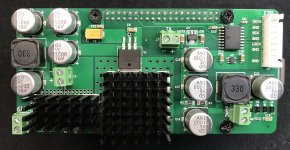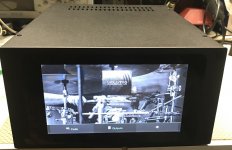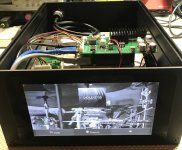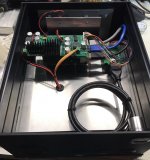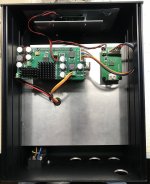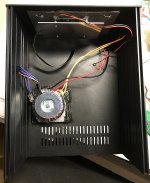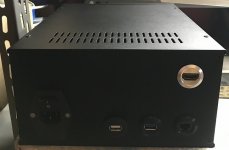Sorry, I mean for I2S sources other than the Rpi e.g a USB interface.
I suppose a board like this would functionally be the same as the TWSAFB-RPI, just connect a different i2s source to its Rpi i2s input header, if that's what you intend?
I suppose a board like this would functionally be the same as the TWSAFB-RPI, just connect a different i2s source to its Rpi i2s input header, if that's what you intend?
Ok, you can use the TWSAFB-RPI with another source connecting the i2s output of the source to its Rpi i2s input header.
You also have 5Vdc to supply the source if this voltage is suitable.
You also have 5Vdc to supply the source if this voltage is suitable.
That's good.
The 'other I2S board' I mentioned turns out to be the TWSAFB-OI seen in post 39 photos and has already been explained in the first post, it's the isolator* for the DAC of course.
Still, I hope for a simpler/cheaper I2s isolator board in next GB(like the TWSAFB-RX minus HDMI LVDS receiver) for connecting any I2S source. Too many boards and it's hard to reach MOQs, granted, but I'd expect a lot will be using something other than a Rpi.
The 'other I2S board' I mentioned turns out to be the TWSAFB-OI seen in post 39 photos and has already been explained in the first post, it's the isolator* for the DAC of course.
Still, I hope for a simpler/cheaper I2s isolator board in next GB(like the TWSAFB-RX minus HDMI LVDS receiver) for connecting any I2S source. Too many boards and it's hard to reach MOQs, granted, but I'd expect a lot will be using something other than a Rpi.
Last edited:
Hi! So the TWSAFB-OI is just an isolator? It could then be used for input or output in I2S-reclocker, am I right?
Yes, although it was designed to be used with our new FIFO Lite it could be used in other applications up to 24.576 MHz.
Anyway it's not yet ready, it will be part of a later GB along with the new FIFO and discrete DAC Lite.
Anyway it's not yet ready, it will be part of a later GB along with the new FIFO and discrete DAC Lite.
I mentioned this SD card player before, as a direct I2S source I do not think it performs very well with jitter but it is probably a fairly low noise device, compared to PC or SBC at least, and easily powered with linear supply.
Seems like it would be good for this application? (This is what I will be using as source for the FIFO)
The point of FIFO is that it doesnt matter, The Pi is cheap, relatively low speed, small and flexible so it is a sensible choice, but you did mention possibly creating an SD card player like the one above.
You did mention aswell the lite version of FIFO may have some compromises so an SD player like this could be a good option for us to use in that case at least?
Seems like it would be good for this application? (This is what I will be using as source for the FIFO)
The point of FIFO is that it doesnt matter, The Pi is cheap, relatively low speed, small and flexible so it is a sensible choice, but you did mention possibly creating an SD card player like the one above.
You did mention aswell the lite version of FIFO may have some compromises so an SD player like this could be a good option for us to use in that case at least?
Last edited:
Theoretically the source does not matter because the FIFO Lite is well isolated from it.
The FIFO works in a different time domain so it shouldn't be source dependent, you could use whatever source you want without appreciable difference.
So the device you mentioned should work fine in this application.
There are a few compromises against the Top version of the FIFO, but the architecture is the same.
For example the top version is a 2/3 chassis connetted via fiber optic cable, while the FIFO Lite is a single board isolated by optocouplers.
Of course there are some differences since the cost ratio will be around 1/10.
The FIFO works in a different time domain so it shouldn't be source dependent, you could use whatever source you want without appreciable difference.
So the device you mentioned should work fine in this application.
There are a few compromises against the Top version of the FIFO, but the architecture is the same.
For example the top version is a 2/3 chassis connetted via fiber optic cable, while the FIFO Lite is a single board isolated by optocouplers.
Of course there are some differences since the cost ratio will be around 1/10.
Just a quick question
5/6MHz will support up to 192kHz, is this limited to 16bit?
192 x 16 x 2 = 6.144MHz
5/6MHz will support up to 192kHz, is this limited to 16bit?
192 x 16 x 2 = 6.144MHz
Depending on the output format, with our new discrete DAC Lite you can get 24 bit 176/192 KHz with 5/6 MHz oscillators (24 bit x 192 kHz = 4.608 MHz).
With I2S input DAC to get 24 bit 176/192 kHz you need 11/12 MHz oscillators (24 bit x 2 x 192 kHz = 9.216 MHz).
And so on.
With I2S input DAC to get 24 bit 176/192 kHz you need 11/12 MHz oscillators (24 bit x 2 x 192 kHz = 9.216 MHz).
And so on.
Raspberry PI standalone source
I attach some pictures of the RPI standalone source, it implements the TWSAFB-RPI power supply and I2S isolated output and the TWSAFB-TX I2S over HDMI LVDS transmitter.
The source is controlled by the touch screen, 1TB SSD has been installed to store the music.
I attach some pictures of the RPI standalone source, it implements the TWSAFB-RPI power supply and I2S isolated output and the TWSAFB-TX I2S over HDMI LVDS transmitter.
The source is controlled by the touch screen, 1TB SSD has been installed to store the music.
Attachments
@Andrea
Just a thought: After the somewhat tiresome topic of Soekris-DAC, I am just wondering whether it would not be best to use an AD1865 and something like Ian's I2StoPCM board beforehand (just to avoid all the shift components). Can your FIFO provide a suitable "PCM" output for the AD1865 (or double AD1865)?
Just a thought: After the somewhat tiresome topic of Soekris-DAC, I am just wondering whether it would not be best to use an AD1865 and something like Ian's I2StoPCM board beforehand (just to avoid all the shift components). Can your FIFO provide a suitable "PCM" output for the AD1865 (or double AD1865)?
Last edited:
@Andrea
Just a thought: After the somewhat tiresome topic of Soekris-DAC, I am just wondering whether it would not be best to use an AD1865 and something like Ian's I2StoPCM board beforehand (just to avoid all the shift components). Can your FIFO provide a suitable "PCM" output for the AD1865 (or double AD1865)?
Yes, the new FIFO Lite provides output for almost all DACs, PCM and I2S (PCM63, PCM1704, PCM1794, AD1865, AD1862, TDA1541A, Sabre DAC, AKM DAC and so on).
The output is fully configurable (format, bit depth, speed and so on).
It provides double outputs for dual mono or balanced configuration.
And also it provides a digital calibration to improve the linearity of the DAC.
Thank you! Sounds great. Will think it over. That seems to me to be a more advanced solution. But of course I would be curious to see what more your big DAC can do ...
Will it have UFL connections with input and output devices? As i've noticed it improves noisefloor on Ian's Fifo/reclocking devices compared to ordinary connections with no grounded shields on signal wires..
Will it have UFL connections with input and output devices? As i've noticed it improves noisefloor on Ian's Fifo/reclocking devices compared to ordinary connections with no grounded shields on signal wires..
The new FIFO Lite has both u.fl and JST header output connectors.
Only JST header for the I2S input, since the FIFO isolates the output from the source.
Thanks.
Im no technician, but i listen. So in my case: Rpi with replaced onboard regulators and supplied 1.8, 3.3 and 5v clean linear power, has Ian's IsolatorPi to output "clean I2s", then i2s signal to Ian's Fifo then to Ian's isolator again, then to Ian's dualxo board (with your old driscoll xo), then to my dac - i still felt obvious sound changes after ufl connection between Rpi and Fifo and also after ufl connection from Fifo to isolator to Dualxo board. All devices are powered with very high quality lineqr power supplies.
So my subjective opinion, that his isolators are still prone to let source and also airborn picked noise through.. and therefore both sides ufl connections carry big benefits.
Hope to try your fifo and finally hope to get proper isolation of the source.
Im no technician, but i listen. So in my case: Rpi with replaced onboard regulators and supplied 1.8, 3.3 and 5v clean linear power, has Ian's IsolatorPi to output "clean I2s", then i2s signal to Ian's Fifo then to Ian's isolator again, then to Ian's dualxo board (with your old driscoll xo), then to my dac - i still felt obvious sound changes after ufl connection between Rpi and Fifo and also after ufl connection from Fifo to isolator to Dualxo board. All devices are powered with very high quality lineqr power supplies.
So my subjective opinion, that his isolators are still prone to let source and also airborn picked noise through.. and therefore both sides ufl connections carry big benefits.
Hope to try your fifo and finally hope to get proper isolation of the source.
- Home
- Source & Line
- Digital Line Level
- The Well synchronized asynchronous FIFO buffer - Slaved I2S reclocker
